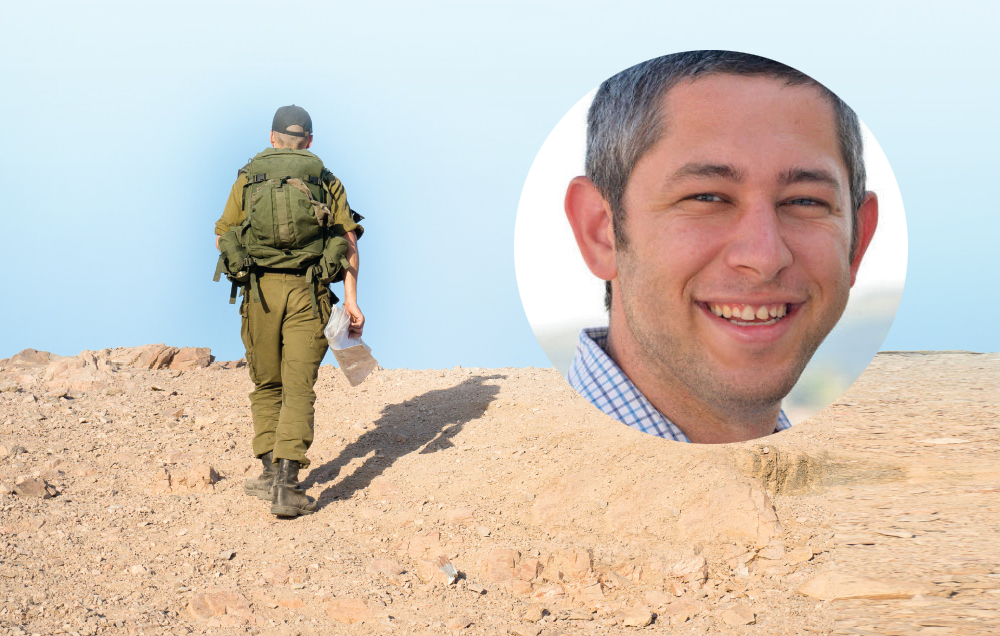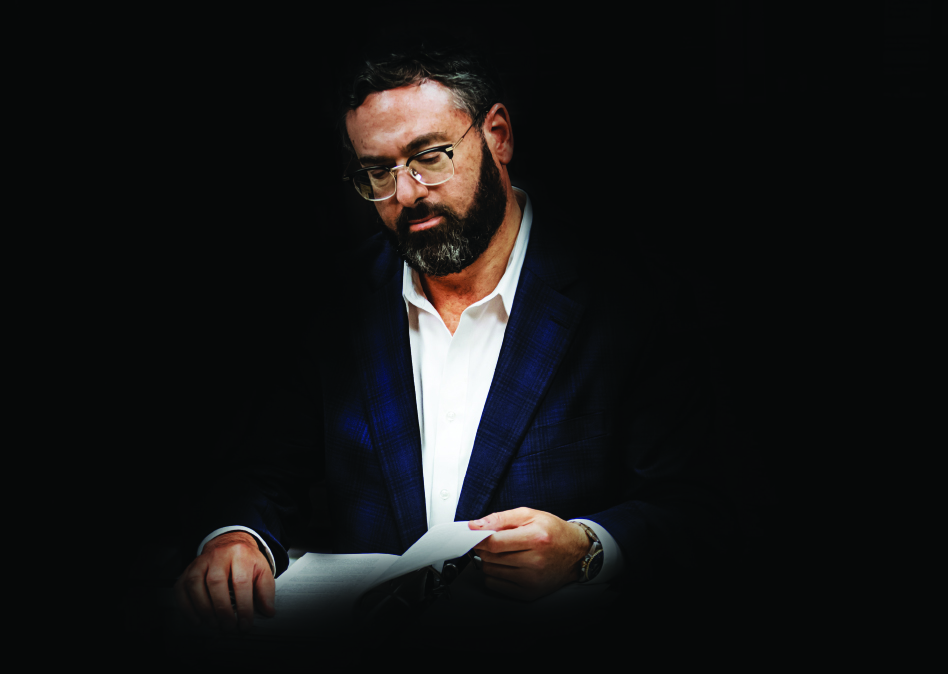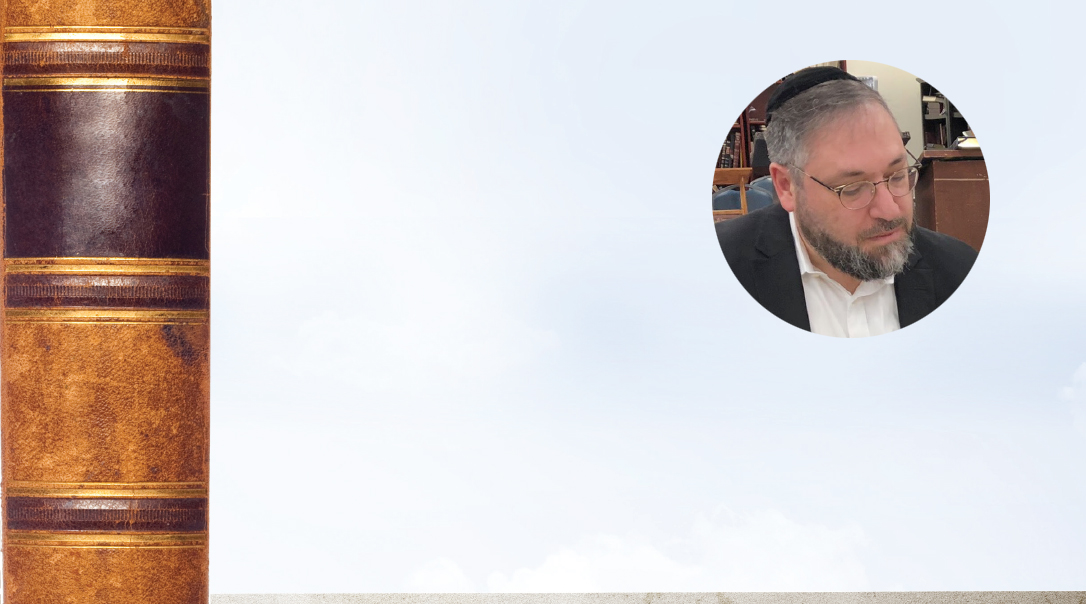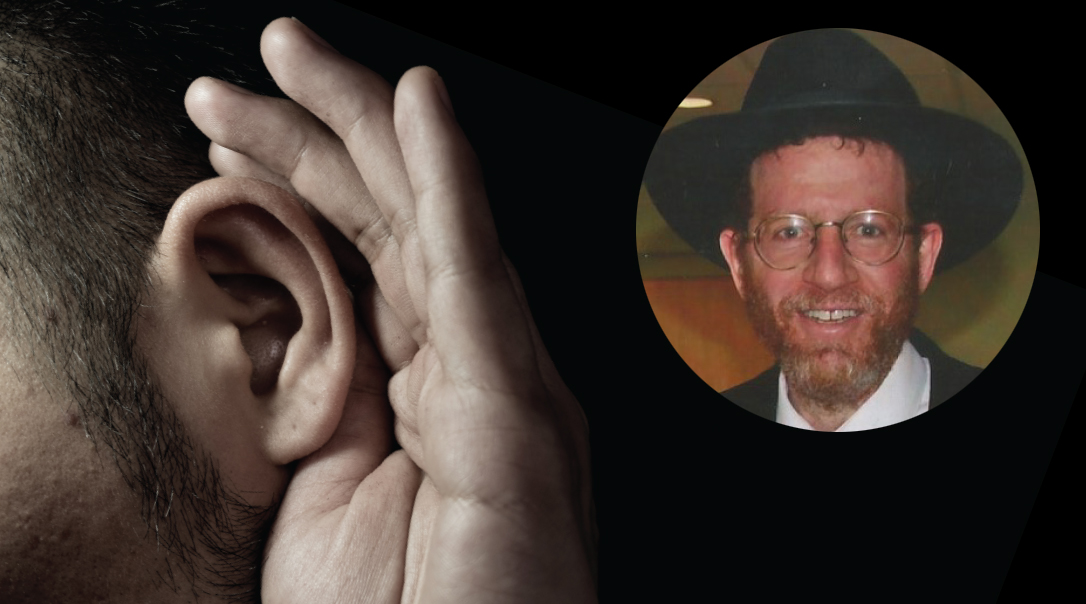They Toil That We May Toil

Three of the stellar team of top-flight talmidei chachamim who toiled for years to complete the Artscroll Shas describe the project’s history and inner workings
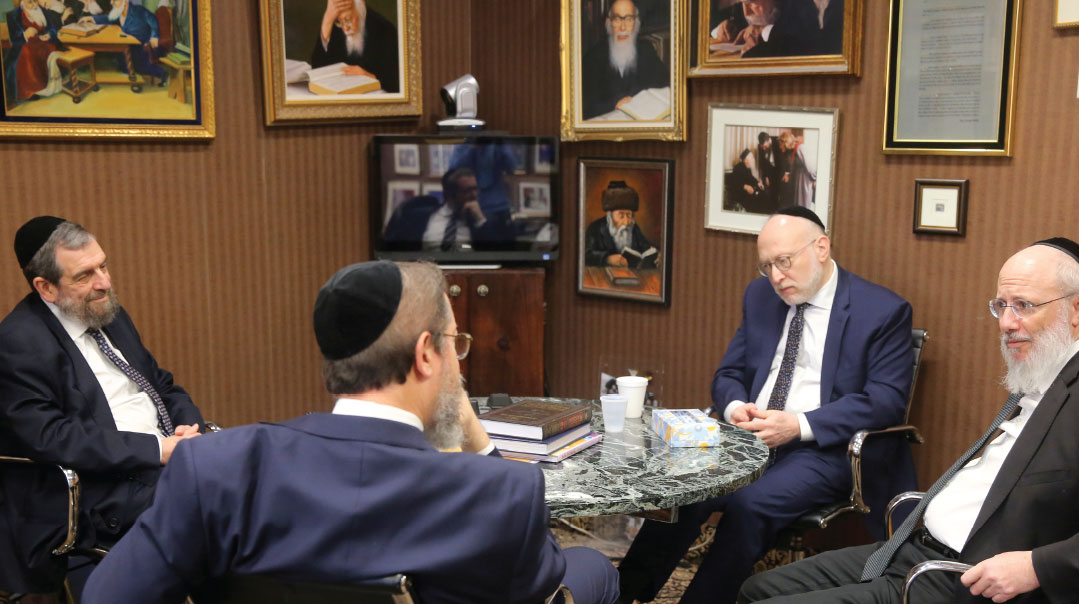
Words like “monumental” are so easily thrown around that when we encounter an accomplishment that’s actually so richly deserving of that superlative — say, a 73-volume masterwork that has opened wide the doors of Shas to a million Jews worldwide — we search for an even greater descriptive, but in vain. So let’s just call the Schottenstein Edition of the ArtScroll Shas what it plainly is — “monumental.”
Monuments have builders — in this case, the stellar team of top-flight talmidei chachamim who toiled for a decade and a half to complete this unprecedented English-language translation and elucidation of Talmud Bavli. What a distinct honor it is, then, to sit with three of that team’s leaders in ArtScroll’s Brooklyn offices as they describe the project’s history and inner workings:
Rabbi Yechezkel Danziger, editorial director of the Talmud Bavli project;
Rabbi Eli Herzka, associate director of the Talmud Bavli project; and
Rabbi Zev Meisels, director of the Tosafos project. All three are or were also directors of the Talmud Yerushalmi project.
Eytan Kobre: One of the things I think people want to know is how you even go about plotting out something of that magnitude. What were its beginnings, and how is something so huge, so complex, taken from an idea to a reality?
Rabbi Yechezkel Danziger: We undertook to do something no one had ever done: To explain every single word in Shas. Every kushya and every teirutz, every twist and turn in the Gemara. That’s an astonishing thing, and had we fully realized the awesome responsibility when we started, I think we might have been too daunted to commit ourselves to it. But it didn’t fully sink in until after a couple of volumes came out.
The original decisions were made together with Reb Meir Zlotowitz z”l, who had a keen insight into what was proper and what was not. One of the first key decisions we made was that we were going to follow the masores of Klal Yisrael for the last 900 years and explain the text of the Gemara exclusively according to Rashi. Other explanations might be added in notes, but the text would always follow Rashi. It can be tempting to pick whichever pshat is the simplest to explain, but then we would be in the position of deciding, so to speak, which explanation is the correct one, and it’s not for us to make such decisions.
We also wanted to make sure that people would know the literal meaning of the Gemara’s own words, but also be able to follow the flow of the Gemara’s give-and-take easily. On the one hand, we were determined to make sure that people knew what the actual words meant, because that’s how you develop the skill to learn Gemara on your own so that you’re not forever beholden to a translation.
But following the lead of all good rebbeim who teach has’chalas Gemara, we wanted people to understand each step in the Gemara’s reasoning or in a machlokes between Tannaim or Amoraim, to know this is a question, this is an answer, this is a proof, and this is a rejection of a proof. This is critical to understanding the Gemara. So we bolded the English words that correspond to the literal translation of the Gemara’s words. The other connective English words that provide the flow of the Gemara were left un-bolded. This way people can see which are the actual words of the Gemara and which are explanatory words.
Sometimes, however, it’s necessary to translate a phrase in the Gemara idiomatically, because the literal translation is very distant from anything that makes sense in English. In such instances, there is a footnote stating that “literally” the word means this.
The first masechta we published was Makkos — it’s probably a collector’s item — and instead of so many notes on pshat, we had notes that gave interesting lomdus, a machlokes Rishonim, a kushya of Rav Akiva Eiger, etc. But then Rav Zelig Epstein, the rosh yeshivah of Shaar HaTorah in Queens, whom Rabbi Zlotowitz would often turn to as a baal eitzah, advised us to focus more on pshat and more on Rashi. As a result, we produced not only a great peirush on Shas, which gets into various technical details that many peirushim do not get into, but also a great peirush on Rashi. If you want to know shitas Rashi in a sugya, ArtScroll is a tremendous resource for that.
With our conversation taking place shortly after the tragic passing of Rav Chaim Malinowitz ztz”l, who served for many years as a senior editor for the ArtScroll Shas, the talk turns to his contributions and those of his colleagues who served as final authorities for the project.
Rabbi Yechezkel Danziger: Rav Malinowitz originally joined the project because of another loss we had sustained, with the passing in 1993 of the original general editor of the Shas, Rav Herschel Goldwurm. Over the years, I’ve been amazed how much I learned from Rav Herschel, and I consider him to be one of my rebbeim. When he became ill, the brunt of the work fell upon Rav Yisroel Simcha Schorr, who suggested bringing in Rav Malinowitz, who was then a rosh kollel in Monsey and a member of a major beis din there. Eventually he became the main reader for the Shas in both English and Lashon Hakodesh and the Yerushalmi. He was always working on at least four or five projects, and it’s just hard to imagine where he squeezed everything into a day.
Rabbi Zev Meisels: To explain what the position of “reader” is — which should perhaps more accurately be called a “reviewer” — there are the writers who produce the written material, with the next level being that of the editors, who review the writers’ work; and after that it goes to a Reader, with a capital R. This is invariably a great talmid chacham who reviews the material once more in even greater depth, pointing out errors and ways in which its clarity and accuracy can be improved.
Rav Malinowitz was a brilliant, brilliant person who was able to grasp things very quickly and focus in on precisely what the problems were. And he also just didn’t sleep.
We’ve been zocheh to have a number of Readers, each with their own great individual strengths, and that has contributed so much to the project’s success. For example, Rav Yisrael Simcha Schorr, besides being a tremendous talmid chacham, has a particular facility in machshavah and in drush, and without him, the aggadeta sections wouldn’t have been of the same high quality as the rest of the Gemara.
Rabbi Yechezkel Danziger: And when you pushed to find a teirutz to a kushya, he’d come up with the most astonishing things.
Rabbi Zev Meisels: He knows seforim. “I remember seeing in such-and-such sefer 43 years ago…” and he goes to the beis medrash, he pulls it off the shelf, opens to the page, and there it is.
For many years, one of our readers was Rav Mordechai Marcus, an awesome talmid chacham, who was also extremely meticulous in pshat. If a writer got things wrong, he’d soon receive Rav Marcus’s comments written in very small Hebrew lettering between the lines of the manuscript, which he’d then have to decipher. And if the editor didn’t agree, you could call him, but you had to be really, really prepared, because he had the pshat of the sugya completely worked out.
Rabbi Eli Herzka: I’ll mention another reader whom we were zocheh to have, Rav Efraim Zuravin ztz”l. I specifically remember when I was working on the first few perakim of Yevamos, which was a favorite masechta of his. He was living in Eretz Yisrael, and we would spend hours on end fighting through the sugya, battling it out on the phone.
Rabbi Yechezkel Danziger: There was also Reb Eli Herzka’s cousin, Rav Nosson Baruch Herzka ztz”l, with whom I worked a lot.
Rabbi Zev Meisels: Personally speaking, the ability to interact and speak in learning with these people is for me one of the greatest things. That I could be zocheh to sit on the phone and speak in learning with Rav Yisrael Simcha Schorr is something very special.
Rabbi Yechezkel Danziger: I have long said that one of the great fringe benefits of working in ArtScroll is that I get to rub shoulders with people who are of a level that I would otherwise never have access to. And I got to know some very great people.
Rabbi Eli Herzka: As the level of sophistication of the project rose, those using the Shas appreciated it, spurring a desire for more, which in turn meant the level had to rise even further. Eventually we decided to keep it at a certain level, and not any higher, so that the main purpose of the work would not be lost. The aim was to provide the full pshat while also addressing the questions that would bother the average lomeid, the things that an intelligent person learning the sugya and keeping track of the shakla v’tarya would be puzzled by.
Rabbi Zev Meisels: We also sometimes discuss famous kushyos, things that we know people will expect us to address. And, of course, we cite many mar’eh mekomos to enable people to take their learning even deeper.
Rabbi Yechezkel Danziger: Speaking of asking the basic questions, I once received a call from someone who said he had a kushya on that day’s daf and was upset that we didn’t address it. He told me the kushya, and I agreed it was an excellent question. After the call ended, I started looking around, first in the Maharsha, then the Pnei Yehoshua, the Rashash, the Sfas Emes, all the main Acharonim who talk about pshat. None of them discussed this problem.
So finally I called the fellow back and I said to him, “I don’t know why you’re upset with us. It’s a very good kushya, but the Maharsha didn’t ask it, nor did the Pnei Yehoshua, the Sfas Emes or the Rashash. So why are you angry at us?” That showed me people had come to expect a certain level of pshat from the ArtScroll Shas.
Rabbi Eli Herzka: A relative of mine who attends a Daf Yomi shiur told me that what the ArtScroll Gemara did for him was this: It used to be that when someone in the shiur asked a kushya — and it might have been something that was bothering everyone there — if the maggid shiur hadn’t thought of the kushya, he would dismiss it because he didn’t know the answer. So people would get the feeling something must be wrong with them since they didn’t understand the Gemara.
But once ArtScroll appeared and they found that the questions bothering them were addressed in the notes, they realized they were really on the right track. It gave them a geshmak to know they were asking a legitimate question about the basic pshat of the sugya.
I must add that Reb Yechezkel gets credit for training the entire staff, so that despite the fact that we have different writers for the various masechtos, the material is uniform in style and approach. Someone with a keen eye for detail can perhaps tell the difference between one sugya and another, but the average person will have difficulty discerning the point at which one writer concluded and another commenced his work.
A project of such immense magnitude as the ArtScroll Shas requires a staff of unusually talented people, and both the challenges and rewards of working on it must be commensurately large.
Eytan Kobre: How did you find the writers and editors for the project?
Rabbi Yechezkel Danziger: The Ribbono shel Olam found them for us. We picked them up at a rate of one good new person every 12 to 18 months. When you start a project, you have to go with the people who are available to you, and over the course of time we developed better editors, better writers. But for every group of people who sought a position, only one made it.
Rabbi Zev Meisels: It’s very difficult to find really good editors. The qualities we look for are, obviously, being able to learn well and to write well. But the ability to be very focused on detail and have the patience to go through the material repeatedly without tiring or losing interest are also very important. We also look for meticulousness and precision. A person can be very brilliant, but he might be thinking on a much higher plane without wanting to address the so-called “little pshat problems” that are actually very important.
Rabbi Eli Herzka: I would add that it’s also crucial for our writers to possess a sense of what is going to bother people when they are learning the sugya. A person can be a baal kishron, yet lack this understanding.
I vividly remember a conversation with Rav Malinowitz not long after he joined our team. He came aboard not knowing what to expect and was very pleasantly surprised — he was really taken by what we were doing. And he said, “I always knew that the Torah is ein sof, that a sugya has no end. But what I discovered here is that even without getting into lomdus and reid, the pshat itself is ein sof. There is no end even in the pshat of the sugya.”
And again, the fact that we have always stayed with Rashi has meant that we have been forced to sit and work really hard to figure out what Rashi means, with no other way out. We couldn’t just say in a given sugya that we were going to learn it using the Rashba’s approach. That opened up sugyas, it opened up tremendous things.
Rabbi Zev Meisels: It’s important to understand that when you are elucidating something in English, there are no shortcuts. You can’t just translate the literal words of Rashi and say, “Here is what Rashi says, now go read it yourself and figure it out.” As a writer, you are forced to actually explain it in English in a way that people can understand. That means the writer himself must really understand it before he writes.
Rabbi Eli Herzka: Ultimately, we needed a lot of siyata d’Shmaya, and we received it. One example of many occurred when I was writing on a sugya in the second perek of Kiddushin, and Rav Yisrael Simcha was the Reader. I remember being on the phone with him at night trying to figure out a difficult Rashi and we left it as a stalemate. We hung up, and he went to daven Maariv.
A half an hour later, he calls back and says, “I came into shul a few minutes early and there was an Achiezer on my shtender, so I opened it up and he talks about this Rashi.” We constantly experienced siyata d’Shmaya beyond what you could imagine, due undoubtedly to the zechus harabim.
Rabbi Zev Meisels: When you mentioned siyata d’Shmaya, it made me think of the many, many times there were difficulties in the sugya where I was completely stymied and I just didn’t know pshat. I don’t consider myself any great talmid chacham, but by just throwing myself into it and pushing myself, I found many times that the Ribbono shel Olam just opened up my mind to understand things.
I remember when the idea of my working in ArtScroll first arose, I was a yungerman and I was happy learning in kollel. I thought to myself, Why do I need to leave kollel? But Reb Meir called me and said, “Do you know how many people are going to be learning what you write? Do you understand what a zechus it is?” Baruch Hashem that I, an insignificant person, was zocheh to give Torah to so much of Klal Yisrael… It’s an amazing thing.
Rabbi Eli Herzka: There’s another factor we’ve discussed among ourselves many times, which is that there were no egos involved. We worked as a team, and very rarely did anyone get credit for his individual contributions. The editors are only listed at the beginning of each volume, and no one outside of ArtScroll knows who did what and how much work each person put into the sugya. There was tremendous achdus among the staff, and I believe that was also responsible for our being zocheh to achieve what we did.
Rabbi Yechezkel Danziger: When we were doing Eiruvin, we worked very hard to get it out in time for the daf yomi calendar. But then many dapim had to be redone completely, and we didn’t have the staff yet that we had later on, so we came in on four wintertime Motzaei Shabbosos in a row and were here until midnight.
Even later on, we had so many very late nights, even all-night sessions here. We used to have supper here and stay and work until who knows when, just to get it done. The Daf Yomi learners needed it, and people had complaints against us if it did not come out on time.
In one case, I recall — I think it was Kesubos — we were a couple of weeks late with one volume. I remember Meir letting us listen to a voice mail he had received in which the caller was irate, screaming, “How could you let us down? We are waiting for this Gemara.”
So Meir pushed and pushed and pushed to get it done. But the fact is it was a staff comprised of talmidei chachamim who weren’t going to allow something to be published unless it met their high standards.
Rabbi Yechezkel Danziger: One thing that must be said is that there are a lot of unsung heroes who were part of this effort. Those of us here ended up heading projects, so our names are out front, but we didn’t do the lion’s share of the work. There are a lot of very dedicated, very qualified, very talented editors and writers who worked on that. They are unsung.
Rabbi Eli Herzka: The support staff, the writers, the editors, the reviewers — all worked with mesirus nefesh. They put their heart and soul into this and the credit goes to them.
Rabbi Zev Meisels: When I told my kids that we’re having this discussion, they started reminding me about things I had forgotten, about the daf yomi–driven deadlines, and how it was as if I were chained to the desk and couldn’t move. They’d have to bring me a sandwich. I forgot it all already, because it’s been so many years, but to them, it’s how they grew up, seeing this.
How did the project first get underway? And has the ArtScroll Shas remained exactly as it was when first published, or have changes taken place over the years?
Rabbi Yechezkel Danziger: The first masechta we published was Makkos. We chose that masechta for two reasons: First, they learn it in yeshivos, especially with younger bochurim. Second, it was a perfect masechta to do because it has every type of sugya, so that 80 percent of all the issues we ever had to face in the project came up in Makkos.
We did Eiruvin next because there was a new cycle of daf yomi starting then, and it was not possible for Berachos and Shabbos to be out in time for the daf yomi learners to use them. We could have done Megillah and Taanis in time for the cycle, but people might have thought we were cherry-picking the easy masechtos. By doing Eiruvin, everyone knew we were in it for real.
But since Eiruvin was done in the very early stages of the project, it was not at the level to which the later stages of the project would rise. And so at some point we redid many of the perakim of Eiruvin.
One of the things I would like to do someday is go over some of the masechtos, especially ones used by younger students, and just lighten up the language, which is over the heads of many people today. The young generation today doesn’t speak English at that level.
Rabbi Eli Herzka: Even in the secular world, you can open up any secular publication and compare the writing with that of the same publication from 20 years ago, and it’s a completely different level of English. You don’t notice it because it’s happening so slowly and it’s subtle, but if you make the comparison, you see it’s not the same at all.
Rabbi Zev Meisels: It’s not just a matter of which words you use, it’s also the style of writing. It’s about keeping the sentences shorter, and not making sentences with 14 clauses.
As one of the greatest endeavors of harbatzas Torah of modern times, the burgundy-toned volumes of the ArtScroll Shas with their distinctive gold lettering are a ubiquitous sight in the homes, schools, and shuls of Jewish communities worldwide. The editors share some examples illustrating the reach and impact of this trailblazing project, from beginners to serious lomdim to the greatest leaders of our people.
Rabbi Yechezkel Danziger: I got a letter once from Tasmania, an island off the southern coast of Australia with a small population of people who raise sheep to produce wool. The writer introduced himself as one of four Jews on the island and said he had started learning Gemara with one of the other three Jews using a volume of the ArtScroll Shas, and even making a siyum. So 50 percent of Tasmanian Jewry used the ArtScroll Shas.
Another memorable letter we received was from a fellow who was a farmer living in North Carolina and had been given an ArtScroll Gemara by someone. He started learning and eventually his entire family became frum and they moved somewhere in upstate New York. Reb Meir had a number of such letters from people describing the impact the Shas has had on them and thanking us for what it did for them.
Then, of course, there are the very large numbers of people learning daf yomi as a result of the ArtScroll Shas. Before the ArtScroll Shas came along, the Siyum HaShas would inspire many people to start a new machzor of daf yomi They’d make it through Berachos, after which many of them would drop out during Shabbos, with most of the rest giving up when it came to Eiruvin. But when, as I mentioned earlier, we came out with Eiruvin in time for the daf yomi cycle, and that was the first time that large numbers of people who had joined the daf yomi actually made it through Eiruvin. And once they did so, they were able to continue.
Rabbi Eli Herzka: Rav Elyashiv, in his insatiable thirst for Torah, would often look through seforim written by people whose yedias HaTorah was much less than his own. It’s well known that after Rav Elyashiv prepared his nightly shiur, he would look at the Schottenstein Hebrew Gemara, to glance at the he’aros.
When we came out with the volume on Elu Treifos, it was a breakthrough. An interesting thing should be mentioned — Reb Meir invested a fortune in diagrams and artwork, especially in Chullin. We hired professional artists and in one case, a wildlife artist.
When the Eilu Treifos volume was published in Lashon Hakodesh, the first run was printed in Eretz Yisrael on a Friday morning. Rav Eliyahu Meir Klugman got the first copy and brought it to Rav Elyashiv about an hour before Shabbos. Later, he met Rav Efrati, who told him, “You should know that from when you brought the Gemara until the Rav went to shul, he didn’t put it down.” He was sitting there, going through the whole thing. Of course Rav Elyashiv didn’t need our peirush, but it’s a great zechus to have produced something that he felt was worth his time.
No discussion of the ArtScroll Shas can proceed very far without a mention of Rabbi Meir Zlotowitz, the unforgettable visionary whose brainchild it was, and the Schottenstein family, who were its patrons.
Rabbi Eli Herzka: Rabbi Meir Zlotowitz conceived of the project and was the driving force behind it. Besides his many, many other talents, he had a tremendous lev tov. I mentioned before the achdus among the staff and in no small measure, that was a credit to him, because he really loved people and knew how to deal with people and how to be mechabed people.
Rabbi Yechezkel Danziger: Reb Meir Zlotowitz was the one who conceived of the project, and he received chizuk from Hagaon Harav Yaakov Kamenetsky because when he started, people thought he was crazy. “You’re going to put out a Shas in English? Who’s going to buy it? Who’s going to use it?”
When later he decided to do the Shas in Lashon Hakodesh, even I thought he was crazy. “Who’s going to use your Shas in Lashon Kodesh?” And today it’s widely used in Eretz Yisrael.
Do you know how many yungeleit there are today who, in addition to all their learning in kollel, also learn daf yomi because bein hasedorim they can go through the daf in 40 minutes using the Hebrew ArtScroll Schottenstein Gemara?
Rabbi Eli Herzka: But aside from his administrative talents, Reb Meir knew how to learn, and he had a chush for how to explain things, how to teach things, how it is supposed to look. He would criticize sometimes the way something was presented, saying the language is too hard. At some point we were getting more sophisticated, and the notes were filling up the page and he would constantly say, “It’s getting to be too much for people, people are not going to be able to digest this, you have to contain it.”
When we started working on the commentary of the Ohr HaChayim in English, he sat for the first few weeks, reviewing the files and toning it down. He was an excellent editor, and although after the first few years, he didn’t have the time to write and to edit, he had a tremendous chush, and he was able to go through it and show you where and how it could be done better.
Rabbi Yechezkel Danziger: And he also had the great drive to keep the project funded. In all the years we worked for him, never once were they late on a payroll.
Rabbi Zev Meisels: And the pioneering way in which he funded it. This whole chiddush of a foundation and securing private dedications of books. Nowadays that’s commonplace, but I think it was a big innovation when it began.
Rabbi Yechezkel Danziger: He was a very creative person, and really all our big projects were his ideas.
Rabbi Zev Meisels: Yerushalmi was his brainstorm, and b’ezras Hashem there will be a siyum this coming year in May, close to his yahrtzeit, on the English Yerushalmi. He also had the courage to jump in, and rather than say, “Let’s first finish this and then we’ll start that,” he’d say, “No, we’re starting this other project now.” In other words, while the English Bavli was still not yet complete, he decided we should start on the Hebrew Bavli. Similarly, the English Yerushalmi began while the Hebrew Bavli was still going, and the Hebrew Yerushalmi was started while the English Yerushalmi was still underway. These were big undertakings, which meant a big staff and a lot of fundraising, and it was not easy.
Rabbi Yechezkel Danziger: The Yerushalmi project was very dear to his heart. He used to say that someday it will be recognized that Yerushalmi was our biggest contribution.
Rabbi Zev Meisels: There are really serious talmidei chachamim who’ve told me they learn our Yerushalmi.
Rabbi Yechezkel Danziger: There was a serious kollel, I believe in Bnei Brak, that was learning Zeraim and would only decide which masechta to learn when they knew which volume of the ArtScroll Yerushalmi on Zeraim was coming out.
Rabbi Zev Meisels: What a zechus the Schottenstein family has for making all this possible.
Rabbi Yechezkel Danziger: They literally earned themselves a seat on the mizrach vant in Gan Eden.
Rabbi Eli Herzka: It’s interesting that when the Ramban project was starting, there was a certain potential sponsor I knew, and I went on Reb Meir’s behalf to offer him the sponsorship of the project, which he could have undertaken with no problem at all. But at our meeting, his advisor on charitable giving belittled the idea. I was very disappointed, and when I reported this back to Reb Meir, he was not concerned at all. He said the fellow didn’t have the zechus. The Ribbono shel Olam saved us from someone who didn’t have the zechus to fund it.
He said that over the years, he had seen how people could potentially have sponsored things, but they did not work out, and in the end it was much better that we weren’t associated with those people. Better people ended up doing it and it was a zechus.
Rabbi Yechezkel Danziger: It was not commonly known, but before the Schottensteins agreed to sponsor the Shas, there was another very wealthy family whose name I am not going to mention, who at the time were very highly respected. There were negotiations, but in the end it didn’t work out, and Reb Meir remembered the words of his rebbi, Rav Moshe Feinstein ztz”l, who said, “Every project will get done, it’s just a matter of who will have the zechus to sponsor it. They don’t have the zechus.” He was a big maamin and he would always bring siyata d’Shmaya into the conversation.
He would sometimes tell us that a certain project was something the Ribbono shel Olam wanted to make happen, and we were given the zechus to do it. If we didn’t do it and we didn’t push ourselves to do it as fast as we could, it would still get done — but somebody else would get the zechus.
And the relationship he developed with the Schottenstein family was unbelievable. When Reb Meir passed away, Mr. Jay Schottenstein flew from Europe to Eretz Yisrael to attend the levayah and in his hesped, he spoke of Reb Meir almost like a father. They developed a very, very close relationship. Knowing that the Schottensteins were behind the project made everything a lot easier. This enabled many other generous friends to add their valuable and significant contributions, which brought the project to completion.
Eytan Kobre: And they have gone on to sponsor many other major projects.
Rabbi Zev Meisels: They sponsored both Hebrew and English Bavli, both Hebrew and English Yerushalmi, the Mishnah Elucidated, the Chinuch, all the interlinear siddurim and a new project, the Ein Yaakov.
Rabbi Yechezkel Danziger: I sometimes marvel at how the Schottensteins had this great zechus. There were many other wealthy Jews who could have done it. I remember Jay spoke at a dinner we made for his father’s 20th yahrtzeit and he told a story about what his father had done during the Depression.
They owned a square block in downtown Columbus, Ohio where they had a massive department store, but during the Depression, they weren’t selling in the same volume, so they didn’t need a store of that size. So to survive, they needed to rent out about half the building, but since it was a square block, it was hard to find a tenant to rent it from them.
They finally found a potential tenant, and he wanted to close the deal Friday afternoon. But Jay’s grandfather told him, “Friday afternoon I can’t do it unless we are finished by 1 p.m. If you want, I can do it Saturday night.”
The other party told him if he wouldn’t sign on Friday, the deal was off. He was risking his whole business, but he said, “If it’s Friday, I can’t do it. I have to be home in time for Shabbos.”
They told him the deal is off. But on Sunday morning they called him up, having realized he wasn’t just playing games with them, and made a deal with him. And I always thought maybe that was the zechus the Schottensteins had that enabled them to sponsor this project.
(Originally featured in 'One Day Closer', Special Supplement, Chanuka/Siyum HaShas 5780)
Oops! We could not locate your form.






